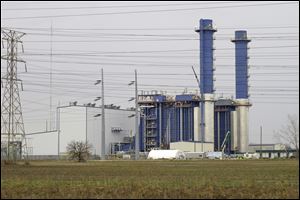
State board approves plans for second Oregon natural gas power plant
12/7/2017
The Oregon Clean Energy Center pictured in April.
Construction is expected to begin in January on Oregon’s second major power plant fueled by natural gas, a $900 million project that reinforces how America’s fracking boom is upending the energy marketplace.
The Ohio Power Siting Board on Thursday agreed to issue a permit to a Massachusetts developer planning to build the 955-megawatt project on behalf of Clean Energy Future-Oregon, LLC.
Plans call for that plant to begin operating in 2020 next to the 960-mw Oregon Clean Energy plant that went online this summer.
Both are attractive to the 13-state regional grid operator that includes Ohio, PJM Interconnection LLC, because each will have the capacity to produce more electricity than FirstEnergy Corp.’s cash-strapped Davis-Besse nuclear plant in nearby Ottawa County.
FirstEnergy has said it may close Davis-Besse prematurely unless it finds a buyer or gets assistance from the Ohio General Assembly to help that plant and its Sammis coal-fired power plant in southern Ohio. Rock-bottom natural gas prices have resulted in coal and nuclear plant retirements elsewhere in the United States.
Matt Schilling, the state siting board’s spokesman, told The Blade the second Oregon natural-gas plant’s final approval faced no major obstacles in getting approval. Hearing transcripts show the first plant’s operators raised a few concerns about access during construction, but that those have been resolved.
Fracking, short for hydraulic fracturing, has been around for decades. The game-changer occurred about 10 years ago, when the oil and gas industry developed a horizontal drilling technique that suddenly opened up vast supplies of previously trapped fossil fuels worldwide.
There are large gas reserves in the Marcellus and Utica shale regions of eastern Ohio, western and central Pennsylvania, and West Virginia. As a result, additional pipelines are being built across Ohio.
Ohio’s energy landscape has changed dramatically since a decade ago, when the state got about 85 percent of its electricity from burning coal and much of the rest from nuclear plants. Ohio historically has been one of America’s most coal-reliant states.
Ohio now gets 59.8 percent of its electricity from coal, still well above the national average but much less than just a few years ago. Its percentage of electricity from natural gas now exceeds 24 percent, according to the U.S. Energy Information Administration.
The natural gas share is expected to keep rising now that 10 plants across Ohio are in various stages of planning, design, construction, or early operation.
“It’s all driven by economics,” Mr. Schilling said. “When you look at the amount of power generated in Ohio, the share of natural gas has been increasing.”
In testimony delivered to the state siting board Sept. 22, William Siderewicz, Clean Energy Future-Oregon’s president, said the project helps fill a void left by closings of coal-fired power plants in Ohio and Michigan and continued uncertainty of FirstEnergy, which he said “has experienced serious financial issues, which puts the future of the nearby Davis-Besse nuclear plant in question.”
In an interview with a Columbus business publication, Mr. Siderewicz said market conditions favoring natural gas have resulted in a “stampede to Ohio.”
Transcripts of recent testimony also show Oregon City Administrator Mike Beazley touted the project as a job-producer, and one that could reduce local energy costs while stimulating new development.
“We have a very good experience with the last power plant, and we expect the same for this one,” Oregon Mayor Michael Seferian testified.
Andy McClure, administrator of Toledo’s Collins Park Water Treatment Plant, said Toledo will provide cooling water.
“And the construction is also a good opportunity for the cities of Toledo and Oregon as an interconnect as a backup water supply for both communities,” Mr. McClure testified.
Hal Gregory, Oregon’s superintendent of schools, said tax revenue from those plants will help the district better afford school programs, while Joe McNamara, Toledo senior attorney, echoed those points, including the water deal between Toledo and Oregon, which he said shows “that northwest Ohio is open for business.”
Mr. McNamara said in his testimony that Toledo Mayor Paula Hicks-Hudson “wholeheartedly” supports the project.
Contact Tom Henry at thenry@theblade.com, 419-724-6079, or via Twitter @ecowriterohio.